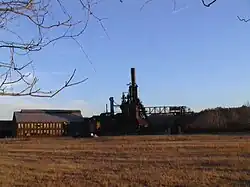Homestead Steel Works
Homestead Steel Works was a large steel works located on the Monongahela River at Homestead, Pennsylvania in the United States. The company developed in the nineteenth century as an extensive plant served by tributary coal and iron fields, a railway 425 miles (684 km) long, and a line of lake steamships. The works was also the site of one of the more serious labor disputes in U.S. history, which became known as the Homestead strike of 1892.


History
The steel works were first constructed in 1881. Andrew Carnegie, (a Scottish emigrant), bought the 2 year old Homestead Steel Works in 1883, and integrated it into his Carnegie Steel Company.[1] For many years, the Homestead Works was the largest steel mill in the world and the most productive of the Mon Valley's many mills.
A series of industrial disputes over wages, working hours and contracts occurred in the early years of the works, leading to the Homestead strike, an industrial lockout and strike which began on June 30, 1892, culminating in a battle between strikers and private security agents on July 6, 1892.[2] The battle was one of the most violent disputes in U.S. labor history and the final result was a major defeat for the union and a setback for their efforts to unionize steelworkers.
In 1896, Carnegie built the Carnegie Library of Homestead in nearby Munhall as part of concessions to the striking workers. (This however has never been validated. Carnegie had the plans drawn up in the late 1880s, and run-ins with the Union bosses kept him from actually building it.)

In 1901, Carnegie sold his operations to U.S. Steel. On January 6, 1906 it was announced that the company would undergo upgrades and expansions worth seven million dollars ($228 million today.) The workforce peaked at 15,000 during World War II.[3] William J. Gaughan was a Senior Designer of Operations Planning and Control at the company who developed computer systems to aid in automation of various operations. Throughout his management career, Gaughan had developed an interest in the history of Homestead Steel Works and began to collect photos and pamphlets regarding the company.[4] The plant closed in 1986 because of a severe downturn in the domestic steel industry, from which the industry still hasn't recovered.


A few remnants of the steel works were not destroyed, including twelve smokestacks in the middle of the Waterfront development.[5] As of its opening in 1999, the land is partially occupied by The Waterfront, an outdoor shopping center.
See also
References
- "Rivers of Steel - Homestead Works". Archived from the original on 2016-03-09. Retrieved 2016-07-25.
- "American Experience: Strike at Homestead Mill". Public Broadcasting System. Retrieved December 30, 2014.
- Article about the Homestead Works on the 20th anniversary of its closing (includes audio), Pittsburgh Post-Gazette (post-gazette.com)
- Rosenberg, David. "William J. Gaughan Collection Finding Aid". Retrieved 18 February 2013.
- Battle of Homestead Foundation
External links
![]() Media related to Homestead Steel Works at Wikimedia Commons
Media related to Homestead Steel Works at Wikimedia Commons
- Pittsburgh Post-Gazette retrospective
- Travel Channel video 1
- Travel Channel video 2
- Images from Historic Pittsburgh
- New York Times article
- Historic American Engineering Record (HAER) No. PA-200, "U.S. Steel Homestead Works" — index page + history.
- HAER No. PA-200-A, "U.S. Steel Homestead Works, Blast Furnace Plant"
- HAER No. PA-200-B, "U.S. Steel Homestead Works, 45-inch Plate Mill"
- HAER No. PA-200-C, "U.S. Steel Homestead Works, 48-inch Plate Mill"
- HAER No. PA-200-D, "U.S. Steel Homestead Works, 100-inch Plate Mill"
- HAER No. PA-200-E, "U.S. Steel Homestead Works, 140-inch Plate Mill"
- HAER No. PA-200-F, "U.S. Steel Homestead Works, 160-inch Plate Mill"
- HAER No. PA-200-G, "U.S. Steel Homestead Works, Main Roll Shop"
- HAER No. PA-200-H, "U.S. Steel Homestead Works, Structural Mill"
- HAER No. PA-200-I, "U.S. Steel Homestead Works, Machine Shop No. 1"
- HAER No. PA-200-J, "U.S. Steel Homestead Works, Machine Shop No. 2"
- HAER No. PA-200-K, "U.S. Steel Homestead Works, Press Shop No. 1"
- HAER No. PA-200-L, "U.S. Steel Homestead Works, Press Shop No. 2"
- HAER No. PA-200-M, "U.S. Steel Homestead Works, Harvey Shop"
- HAER No. PA-200-N, "U.S. Steel Homestead Works, Open Hearth Steelmaking Plant"
- HAER No. PA-200-O, "U.S. Steel Homestead Works, Stainless Steel Processing Plant"
- HAER No. PA-200-P, "U.S. Steel Homestead Works, Auxiliary Buildings & Shops"
- HAER No. PA-301, "Mesta 160-Inch Plate Mill, Defense Plant Corporation, Homestead Works"
